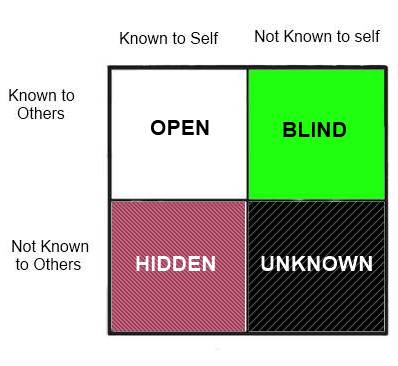I think the best thing about social media is also the worst thing: anyone can say anything. This might lead some people to be more honest and open, but I think it can also encourage some self-delusion, at least as far as a person’s public persona goes.
The Johari Window (see here for a nice resource) is a psychological tool that can help people better understand how they see themselves and others. For the purposes of this blogs post (and only for this blog post) I offer this dumbed-down explanation: the Johari Window can be broken down into four quadrants:
1. Open – things that I and others know about myself
2. Blind – things that others know about me that I am unaware of
3. Hidden – things that I know about myself that others are unaware of
4. Unknown – things that neither I nor others know about myself
Subjects are asked a series of questions regarding what they think of themselves and what they think of others. The “window” shown above is created as a result of those answers. The size of each quadrant depends on the individual: someone with a lack of self-awareness will have smaller “open” and “hidden” quadrants and larger “blind” and “unknown” quadrants.
Whether or not you buy into this concept, I think it can be a useful tool when considering how much stock many companies are placing when attempting to understand user-created content, especially where e-commerce is concerned. In an environment where a person’s opinions are attached to their name, picture/avatar, geographic location and other personal information, and made available to the world at large, you have to at least question a person’s awareness and honesty, particularly when their personal “brand” is at stake.
Consider people who think of and promote themselves as” green” consumers: they might tend to focus on promoting products that are considered eco-friendly and admonishing products that are not. A semantic view of some people might illustrate something different than the way they behave in reality. Maybe they are knowingly cultivating the image of someone who only buys “green” products even if that is not truly the case. Likewise, it’s possible that some people lack enough self-awareness to realize that, while they promote the use of biodegradable recycled toilet paper, their actual shopping behavior might indicate a person who is more concerned with cheaper brands that are easier to find.
The point is there might be more to learn from the way a person has already spent a dollar, as is the case with club card from Safeway or an Amazon account, than there is from reading how they think they are going to spend a dollar in the future, on places like Twitter and other social media platforms.

